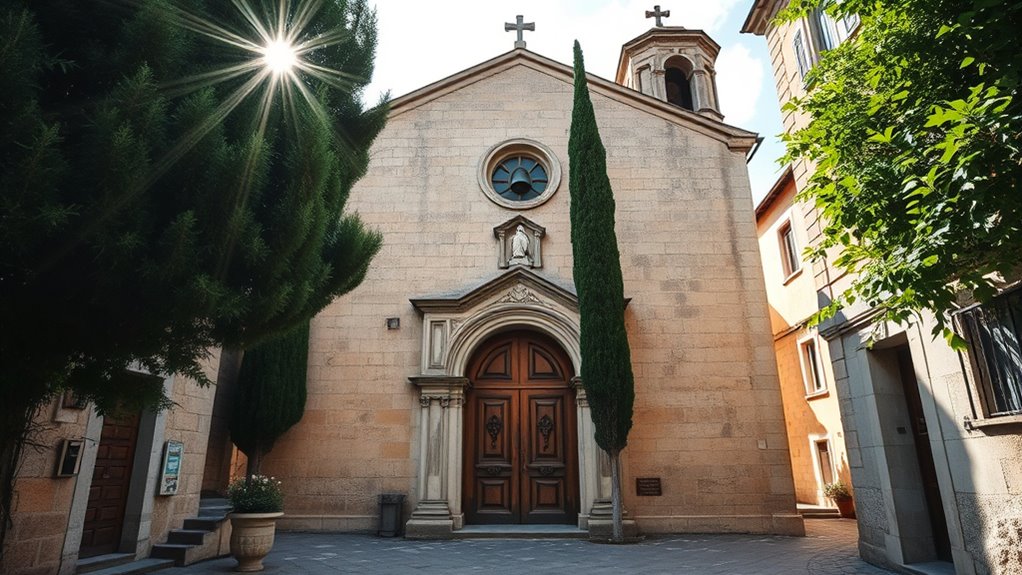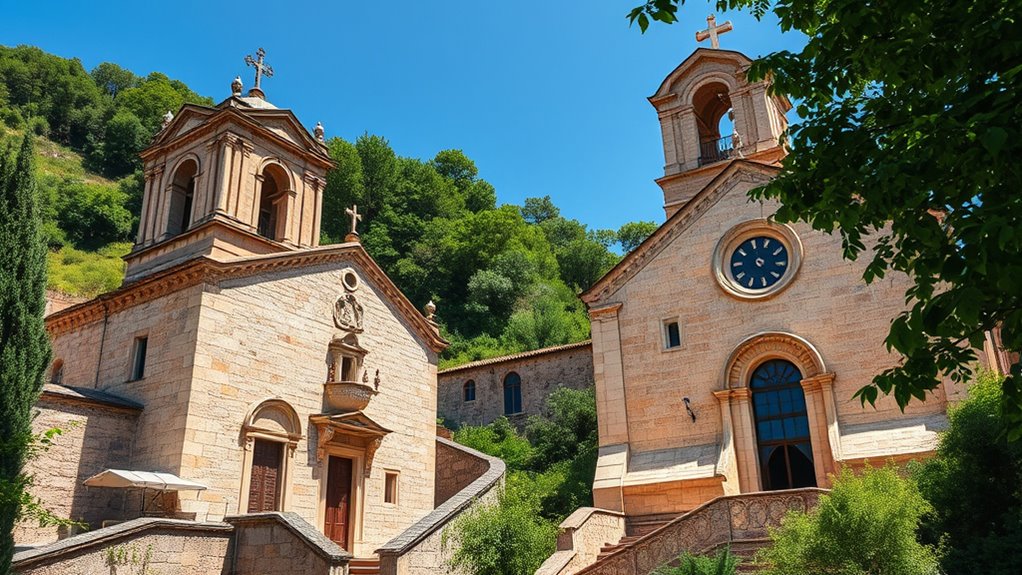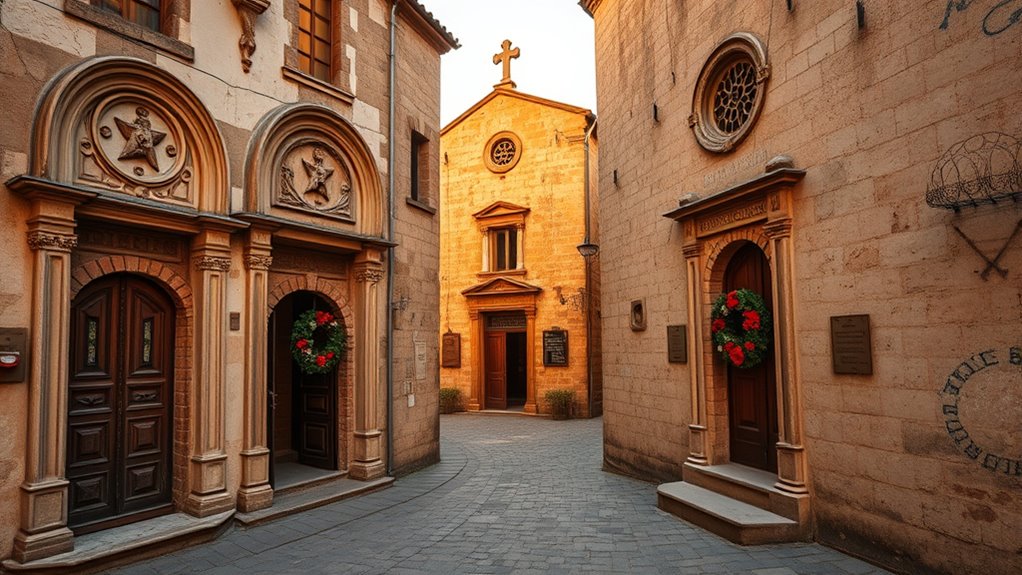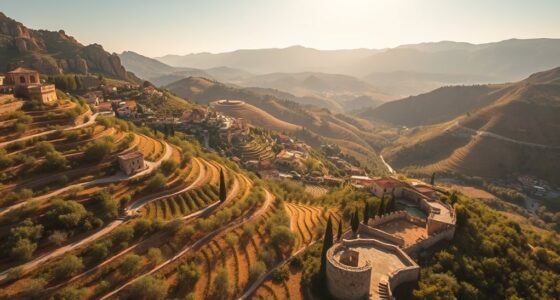Exploring Ittiri’s historic churches offers a fascinating glimpse into Sardinia’s rich monastic and architectural heritage. You can visit Santa Maria di Coros, built on a former Cistercian monastery, or discover the impressive Gothic vaults of San Pietro in Vincoli, renowned for their star-shaped ceilings. The ancient Our Lady of Paulis highlights monastic history, while artistic frescoes and stone carvings add to their charm. Stay tuned to uncover more about their evolution and the serene surroundings that make these sites special.
Key Takeaways
- Santa Maria di Coros and Our Lady of Paulis are key medieval churches linked to Sardinia’s monastic history.
- Architectural styles range from Romanesque and Gothic to neoclassical, reflecting centuries of evolution.
- Notable features include limestone construction, vaulted ceilings, and detailed frescoes by renowned artists.
- Restoration projects have preserved historic structures, highlighting their cultural and religious significance.
- The churches are set within scenic landscapes, offering a tranquil environment for spiritual reflection and exploration.
The Origins and Significance of Santa Maria Di Coros

Santa Maria di Coros holds a pivotal place in Sardinia’s medieval history because it was built on a site that once housed a Cistercian monastery, linking it to a broader monastic network. This site connected to the nearby abbey of Santa Maria di Paulis, emphasizing regional monastic ties during the Middle Ages. The church served both as a priory and hermitage, reflecting its multifaceted spiritual roles. Constructed in the first half of the 13th century, it showcases the influence of Cistercian architecture on Sardinian religious infrastructure. Over time, the structure was modified with additions from the 17th and 18th centuries, but remnants of its medieval origins, like side walls and vaulted ceilings, still hint at its foundational purpose. The site’s rural setting underscores its monastic and hermitic significance. Architectural analysis confirms that the original construction was designed to accommodate monastic life and solitary worship, highlighting its importance in the region’s spiritual landscape. Additionally, the site’s medieval origins demonstrate its integral role within the regional monastic network during the Middle Ages.
Architectural Highlights of San Pietro in Vincoli

As you explore San Pietro in Vincoli, you’ll notice the striking Gothic vault features that add height and elegance inside the church. The neoclassical façade, rebuilt in the late 19th century, emphasizes symmetry and clean lines, contrasting with the Gothic interior. Together, these elements showcase the church’s layered architectural history and evolving style. Additionally, awareness of cybersecurity considerations can help protect digital archives and historical records associated with the site.
Gothic Vault Features
The Gothic stellar vaults of San Pietro in Vincoli stand out as striking features that showcase the church’s medieval architectural heritage. These vaults, dating back to the 15th century, highlight the skill and innovation of Gothic craftsmanship. You’ll notice the complex ribbed patterns forming star-like shapes, supporting the structure while creating a sense of height and grandeur. The intersecting slender ribs produce geometric designs that evoke awe, while allowing more light to filter through larger windows, illuminating the interior. Some side chapels feature these stellar vaults, contrasting with others that have barrel vaults, illustrating the architectural evolution within the church. These vaults, intact through centuries, remain a testament to medieval ingenuity and continue to inspire admiration and reverence. The vaults are constructed using traditional techniques that have stood the test of time. This enduring craftsmanship reflects the Gothic architectural style, which emphasizes verticality and light. – Feel the grandeur of the soaring heights and intricate patterns – Experience the harmony between light, shadow, and Gothic design – Appreciate the craftsmanship preserved through centuries – Witness a living piece of medieval architectural mastery
Neoclassical Façade Design
Since the original façade of San Pietro in Vincoli was demolished in 1881, the church’s exterior took on a fresh identity through a carefully designed Neoclassical style. Architect Salvatore Calvia crafted a façade that emphasizes symmetry, clean lines, and classical proportions. The structure was built using striking red vulcanite stone, giving it a bold yet refined appearance. Skilled local artisans, known as Ichthyrian professionals, brought the design to life, completing construction around 1895. The façade contrasts with the Gothic interior, creating a harmonious blend of styles. It stands as a symbol of cultural pride and religious reverence, marking a significant chapter in the church’s history. The use of architectural symmetry further enhances its aesthetic appeal and classical elegance.
The Monastic Legacy of Our Lady of Paulis

You can explore how Our Lady of Paulis was founded in 1205 through a donation by King Torres Comita II, establishing a essential monastic community. Its architecture, featuring limestone walls, cross-shaped design, and detailed windows, reflects the skill of 12th and 13th-century Cistercian builders. Despite its current ruins, the abbey’s remains reveal its historical significance and connections within Sardinian monastic networks. The abbey was active as a monastic community until the 15th century, highlighting its important role in medieval Sardinian religious life. Additionally, the architecture demonstrates the typical features of Cistercian monastic construction, emphasizing simplicity and functionality.
Origins and Establishment
The origins of Our Lady of Coros (Paulis) trace back to the early 13th century, a period when Cistercian builders introduced their characteristic architectural style to Sardinia. Although no exact date exists, scholars place its construction in the first half of the 1200s, coinciding with the Abbey of Paulis’s rise. This church was part of a larger monastic complex that shaped regional spiritual life and connected Ittiri to other Cistercian sites. The monastery’s strategic presence reflected the order’s influence, blending simplicity with functionality. It served as a religious hub, supporting both communal worship and solitary hermitages. Its establishment marked a significant step in spreading Cistercian spirituality and architecture across Sardinia, leaving a lasting monastic legacy. The monastery’s strategic presence reflected the order’s influence, blending simplicity with functionality. Additionally, archaeological findings suggest the site played a vital role in local trade and communication networks during the medieval period. Recognizing these historical connections can deepen our appreciation for the region’s monastic legacy and its enduring impact on local culture.
Architectural and Artistic Features
The architectural and artistic features of Our Lady of Paulis reveal the enduring monastic legacy carved into Sardinian history. You’ll notice the building’s limestone construction, showcasing 12th-13th century Cistercian masonry techniques. Its church layout, shaped like a “commission” cross, includes three naves divided by arches on pillars and a modest transept facing a square apse with two chapels. The north wall of the apse features a closet, while a Latin cross window and a Greek cross panel symbolize the Trinity. Artistic motifs, like the Greek cross, reflect Cistercian spiritual symbolism. The austere, functional style highlights monastic values of simplicity. Ruins of the cloister and convent reveal the communal monastic life. The design’s orientation and window placement serve liturgical and symbolic purposes, preserving the abbey’s spiritual heritage. Additionally, the use of limestone not only reflects local material traditions but also contributes to the building’s durability and harmony with its natural surroundings. The incorporation of artistic motifs such as the Greek cross emphasizes the importance of spiritual symbolism in monastic architecture.
Artistic Features and Decorations in Local Churches

Artistic features and decorations in Ittiri’s churches vividly reflect a blend of historical styles and local craftsmanship. You’ll notice stunning frescoes by Baldassarre Manca in San Pietro’s chapels, illustrating religious scenes with early 20th-century artistry. Mario Paglietti’s painting in San Pietro’s San Narciso chapel adds a touch of modern ecclesiastical beauty. The intricate stone carvings in Cistercian churches emphasize simplicity and monastic austerity, while stellar vaults and barrel ceilings create mesmerizing patterns of light and shadow. The use of local limestone and red vulcanite stone highlights regional materials, connecting the art to its environment. These decorations evoke emotion through their spiritual symbolism, craftsmanship, and the seamless integration of art and architecture. The churches’ artistic features are also shaped by the influence of the Romanesque style, characterized by arches, pilasters, and strategic window placement that enhance both the aesthetic appeal and interior illumination.
The Evolution of Religious Structures in Sardinia

Religious structures in Ittiri reveal a rich history of architectural evolution, shaped by changing styles, materials, and societal needs over centuries. You’ll notice early churches like Santa Maria di Coros and Our Lady of Paulis, originally monastic complexes influenced by the Cistercian Order. These buildings, dating from the 12th and 13th centuries, used limestone and reflected monastic architectural principles, connecting Sardinian abbeys via ancient routes. Over time, structures like San Leonardo and San Pietro evolved from Romanesque forms to Gothic and neoclassical styles, with renovations and new features added across centuries. Natural and human interventions, such as dam constructions and restorations, have preserved these sites. Throughout their history, these churches served as essential religious, social, and administrative hubs within Ittiri and beyond. Architectural styles in these structures demonstrate a blend of local craftsmanship and broader European influences that have persisted through the ages, highlighting the importance of historical preservation in maintaining their cultural significance.
Preservation Efforts and Restorations of Historic Sites

Preservation efforts in Ittiri’s historic churches demonstrate a committed effort to safeguard their architectural and cultural heritage for future generations. You can see this dedication through multiple restoration projects that have preserved the unique character of these sites. For example, San Leonardo di Cuga was relocated in the 20th century to protect it from the Cuga dam reservoir, with careful dismantling and rebuilding to maintain its historical value. San Pietro in Vincoli underwent extensive renovation from 1881 to 1895, blending Gothic elements with neoclassical touches, involving local artisans and renowned architects. Our Lady of Paulis Abbey’s remains have been restored, highlighting the original construction techniques and landscape. Community involvement, skilled craftsmanship, and ongoing maintenance ensure these treasures continue to inspire awe and connect you to the region’s rich history. Named by Ptolemy and followed by successive civilizations, these structures carry the imprint of centuries of cultural evolution.
- Feel the resilience of centuries-old structures preserved against time and nature.
- Witness the dedication of artisans restoring fading frescoes and carvings.
- Appreciate how relocation and reconstruction honor history while adapting to modern challenges.
- Recognize community passion that sustains these cultural landmarks for future generations.
- The ongoing restoration projects highlight the importance of preserving intangible cultural heritage alongside physical structures.
Experiencing the Spiritual and Cultural Atmosphere

Walking into Ittiri’s historic churches, you’ll immediately sense the deep spiritual atmosphere that has shaped the community for centuries. The churches served as centers for worship, monastic life, and spiritual retreat, creating spaces filled with sacred artworks, iconography, and contemplative ambiance. Walls adorned with paintings and sculptures evoke reflection and devotion, enriching your experience. As you explore, you’ll notice architectural features like Gothic vaults and limestone masonry that elevate the sacred space, inspiring awe. The presence of chapels dedicated to saints and Christ reflects diverse devotional practices, connecting you to centuries of faith. These churches aren’t just historical sites—they’re living symbols of Ittiri’s spiritual and cultural identity, inviting you to immerse yourself in their timeless, reverent atmosphere, and the architectural features such as vaulted ceilings and ornate stonework further enhance their historical and aesthetic significance.
Exploring the Scenic Surroundings of Ittiri’s Churches

The scenic surroundings of Ittiri’s historic churches offer a mesmerizing glimpse into the region’s natural beauty and harmonious landscape. As you explore, you’ll notice the open countryside around Santa Maria di Coros, with its peaceful fields and agricultural land that evoke a sense of timeless serenity. Near San Leonardo di Cuga, the lakeside scenery created by the Cuga reservoir adds a unique, tranquil element to the medieval setting. Rolling hills, Mediterranean scrubland, and shaded trails invite you to immerse yourself in the region’s diverse flora and fauna. These natural features not only enhance the beauty of the sites but also create a peaceful atmosphere perfect for reflection and discovery. This region is known for its diverse native flora and fauna, which thrive in the Mediterranean climate.
- Breathe in the fresh air along scenic trails bursting with regional plants and wildlife.
- Marvel at panoramic views of Sardinian hills and water reflections.
- Relax under trees and shaded paths that connect the churches to lush, natural landscapes.
- Experience the harmony of architecture blending seamlessly with nature’s colors.
Frequently Asked Questions
What Are the Specific Cistercian Construction Techniques Used in Santa Maria Di Coros?
You’re asking about the Cistercian construction techniques used in Santa Maria di Coros. They employed ogival barrel vaults for both stability and beauty, built with locally sourced limestone in a sober masonry style reflecting austerity. The design features a Latin cross layout with three naves, cross-rib vaulting, and simple, durable elements. These methods showcase Cistercian ideals of minimalism and longevity, aligning with regional monastic building traditions of the 13th century.
How Did the Gothic Influence Manifest in San Pietro in Vincoli’S Design?
You see Gothic influence in San Pietro in Vincoli through its pointed arches, stellar vaults, and vertical emphasis. The church’s five side chapels, with their ribbed vaults and intricate ceiling designs, reflect Gothic complexity. Its bell tower showcases the typical Gothic mix of square and octagonal sections. Even after renovations, these elements remain, illustrating how Gothic architecture shapes the church’s majestic, sacred atmosphere, blending history with enduring craftsmanship.
What Role Did Our Lady of Paulis Play in Regional Monastic Networks?
You see that Our Lady of Paulis played a pivotal role in regional monastic networks by linking Sardinia’s Cistercian sites. It connected to Santa Maria di Corte via the “road of the Fathers,” helping expand monastic activities across the region. Its strategic location and administrative ties to Santa Maria di Coros strengthened religious influence, making it a essential hub for spiritual, organizational, and network development in medieval Sardinia.
Are There Any Unique Local Symbols or Motifs in the Churches’ Decorations?
When it comes to local symbols and motifs in Ittiri’s churches, you’ll notice a rich tapestry of cultural influences. You see stellar vaults symbolizing divine light, and volcanic stone highlighting regional materials. Artistic frescoes by local painters reflect Sardinian traditions, while unique architectural features like the bell tower’s shape tell their own story. These elements show that the churches are more than buildings—they’re a visual language telling Ittiri’s spiritual and cultural history.
How Have Restoration Efforts Impacted the Authenticity of These Historic Sites?
Restoration efforts greatly influence the authenticity of these historic sites. You’ll see that careful material choices and skilled craftsmanship preserve original features, while modern techniques enhance durability without compromising appearance. Community involvement ensures that restorations reflect local values, maintaining the site’s cultural significance. Thoughtful updates, like discreet systems, keep the historic character intact, allowing the churches to serve both as preserved landmarks and functional community spaces for generations to come.
Conclusion
As you wander through Ittiri’s historic churches, imagine each as a chapter in a sacred storybook, their walls whispering centuries of faith and artistry. These timeless structures are like ancient trees, their roots deep in history, branches reaching toward the heavens. By exploring their echoes and whispers, you become part of a living tapestry, woven with devotion and heritage — a journey that enriches your soul, forever entwined with Ittiri’s spiritual landscape.









